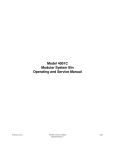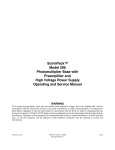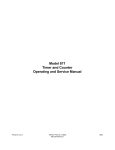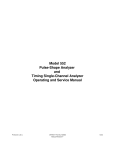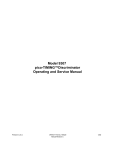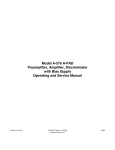Download Model 416A Gate and Delay Generator Operating and Service Manual
Transcript
Model 416A
Gate and Delay Generator
Operating and Service Manual
Printed in U.S.A.
ORTEC® Part No. 733160
Manual Revision E
1202
Advanced Measurement Technology, Inc.
a/k/a/ ORTEC®, a subsidiary of AMETEK®, Inc.
WARRANTY
ORTEC* warrants that the items will be delivered free from defects in material or workmanship. ORTEC makes
no other warranties, express or implied, and specifically NO WARRANTY OF MERCHANTABILITY OR
FITNESS FOR A PARTICULAR PURPOSE.
ORTEC’s exclusive liability is limited to repairing or replacing at ORTEC’s option, items found by ORTEC to
be defective in workmanship or materials within one year from the date of delivery. ORTEC’s liability on any
claim of any kind, including negligence, loss, or damages arising out of, connected with, or from the performance
or breach thereof, or from the manufacture, sale, delivery, resale, repair, or use of any item or services covered
by this agreement or purchase order, shall in no case exceed the price allocable to the item or service furnished
or any part thereof that gives rise to the claim. In the event ORTEC fails to manufacture or deliver items called
for in this agreement or purchase order, ORTEC’s exclusive liability and buyer’s exclusive remedy shall be release
of the buyer from the obligation to pay the purchase price. In no event shall ORTEC be liable for special or
consequential damages.
Quality Control
Before being approved for shipment, each ORTEC instrument must pass a stringent set of quality control tests
designed to expose any flaws in materials or workmanship. Permanent records of these tests are maintained for
use in warranty repair and as a source of statistical information for design improvements.
Repair Service
If it becomes necessary to return this instrument for repair, it is essential that Customer Services be contacted in
advance of its return so that a Return Authorization Number can be assigned to the unit. Also, ORTEC must be
informed, either in writing, by telephone [(865) 482-4411] or by facsimile transmission [(865) 483-2133], of the
nature of the fault of the instrument being returned and of the model, serial, and revision ("Rev" on rear panel)
numbers. Failure to do so may cause unnecessary delays in getting the unit repaired. The ORTEC standard
procedure requires that instruments returned for repair pass the same quality control tests that are used for
new-production instruments. Instruments that are returned should be packed so that they will withstand normal
transit handling and must be shipped PREPAID via Air Parcel Post or United Parcel Service to the designated
ORTEC repair center. The address label and the package should include the Return Authorization Number
assigned. Instruments being returned that are damaged in transit due to inadequate packing will be repaired at the
sender's expense, and it will be the sender's responsibility to make claim with the shipper. Instruments not in
warranty should follow the same procedure and ORTEC will provide a quotation.
Damage in Transit
Shipments should be examined immediately upon receipt for evidence of external or concealed damage. The carrier
making delivery should be notified immediately of any such damage, since the carrier is normally liable for damage
in shipment. Packing materials, waybills, and other such documentation should be preserved in order to establish
claims. After such notification to the carrier, please notify ORTEC of the circumstances so that assistance can be
provided in making damage claims and in providing replacement equipment, if necessary.
Copyright © 2002, Advanced Measurement Technology, Inc. All rights reserved.
*ORTEC® is a registered trademark of Advanced Measurement Technology, Inc. All other trademarks used
herein are the property of their respective owners.
iii
CONTENTS
WARRANTY . . . . . . . . . . . . . . . . . . . . . . . . . . . . . . . . . . . . . . . . . . . . . . . . . . . . . . . . . . . . . . . . . . . . . . . ii
SAFETY INSTRUCTIONS AND SYMBOLS . . . . . . . . . . . . . . . . . . . . . . . . . . . . . . . . . . . . . . . . . . . . . . . iv
SAFETY WARNINGS AND CLEANING INSTRUCTIONS . . . . . . . . . . . . . . . . . . . . . . . . . . . . . . . . . . . . . v
1. DESCRIPTION . . . . . . . . . . . . . . . . . . . . . . . . . . . . . . . . . . . . . . . . . . . . . . . . . . . . . . . . . . . . . . . . . . . 1
2. SPECIFICATIONS . . . . . . . . . . . . . . . . . . . . . . . . . . . . . . . . . . . . . . . . . . . . . . . . . . . . . . . . . . . . . . . .
2.1. CONNECTORS . . . . . . . . . . . . . . . . . . . . . . . . . . . . . . . . . . . . . . . . . . . . . . . . . . . . . . . . . . . .
2.2. CONTROLS . . . . . . . . . . . . . . . . . . . . . . . . . . . . . . . . . . . . . . . . . . . . . . . . . . . . . . . . . . . . . . .
2.3. INPUTS . . . . . . . . . . . . . . . . . . . . . . . . . . . . . . . . . . . . . . . . . . . . . . . . . . . . . . . . . . . . . . . . . .
2.4. OUTPUTS . . . . . . . . . . . . . . . . . . . . . . . . . . . . . . . . . . . . . . . . . . . . . . . . . . . . . . . . . . . . . . . .
2.5. ELECTRICAL AND MECHANICAL . . . . . . . . . . . . . . . . . . . . . . . . . . . . . . . . . . . . . . . . . . . . . .
1
1
1
1
1
2
3. INSTALLATION . . . . . . . . . . . . . . . . . . . . . . . . . . . . . . . . . . . . . . . . . . . . . . . . . . . . . . . . . . . . . . . . . .
3.1. GENERAL . . . . . . . . . . . . . . . . . . . . . . . . . . . . . . . . . . . . . . . . . . . . . . . . . . . . . . . . . . . . . . . .
3.2. CONNECTION TO POWER . . . . . . . . . . . . . . . . . . . . . . . . . . . . . . . . . . . . . . . . . . . . . . . . . . .
3.3. INPUT CONNECTIONS . . . . . . . . . . . . . . . . . . . . . . . . . . . . . . . . . . . . . . . . . . . . . . . . . . . . . .
3.4. OUTPUT CONNECTIONS . . . . . . . . . . . . . . . . . . . . . . . . . . . . . . . . . . . . . . . . . . . . . . . . . . . .
2
2
2
2
2
4. OPERATING INSTRUCTIONS . . . . . . . . . . . . . . . . . . . . . . . . . . . . . . . . . . . . . . . . . . . . . . . . . . . . . . .
4.1. GENERAL . . . . . . . . . . . . . . . . . . . . . . . . . . . . . . . . . . . . . . . . . . . . . . . . . . . . . . . . . . . . . . . .
4.2. MATCHING IMPEDANCE . . . . . . . . . . . . . . . . . . . . . . . . . . . . . . . . . . . . . . . . . . . . . . . . . . . . .
4.3. TYPICAL APPLICATIONS . . . . . . . . . . . . . . . . . . . . . . . . . . . . . . . . . . . . . . . . . . . . . . . . . . . .
3
3
3
3
5. CIRCUIT DESCRIPTION . . . . . . . . . . . . . . . . . . . . . . . . . . . . . . . . . . . . . . . . . . . . . . . . . . . . . . . . . . . 6
6. MAINTENANCE AND CALIBRATION . . . . . . . . . . . . . . . . . . . . . . . . . . . . . . . . . . . . . . . . . . . . . . . . . .
6.1. TESTING PERFORMANCE . . . . . . . . . . . . . . . . . . . . . . . . . . . . . . . . . . . . . . . . . . . . . . . . . . .
6.2. CALIBRATION ADJUSTMENTS . . . . . . . . . . . . . . . . . . . . . . . . . . . . . . . . . . . . . . . . . . . . . . . .
6.3. DELAY RANGE CHANGES . . . . . . . . . . . . . . . . . . . . . . . . . . . . . . . . . . . . . . . . . . . . . . . . . . .
6.4. GATE WIDTH RANGE CHANGES . . . . . . . . . . . . . . . . . . . . . . . . . . . . . . . . . . . . . . . . . . . . . .
6.5. FACTORY REPAIR . . . . . . . . . . . . . . . . . . . . . . . . . . . . . . . . . . . . . . . . . . . . . . . . . . . . . . . . .
7
7
7
7
7
7
iv
SAFETY INSTRUCTIONS AND SYMBOLS
This manual contains up to three levels of safety instructions that must be observed in order to avoid
personal injury and/or damage to equipment or other property. These are:
DANGER
Indicates a hazard that could result in death or serious bodily harm if the safety instruction
is not observed.
WARNING
Indicates a hazard that could result in bodily harm if the safety instruction is not observed.
CAUTION
Indicates a hazard that could result in property damage if the safety instruction is not
observed.
Please read all safety instructions carefully and make sure you understand them fully before attempting to
use this product.
In addition, the following symbol may appear on the product:
ATTENTION–Refer to Manual
DANGER–High Voltage
Please read all safety instructions carefully and make sure you understand them fully before attempting to
use this product.
v
SAFETY WARNINGS AND CLEANING INSTRUCTIONS
DANGER
Opening the cover of this instrument is likely to expose dangerous voltages. Disconnect the
instrument from all voltage sources while it is being opened.
WARNING Using this instrument in a manner not specified by the manufacturer may impair the
protection provided by the instrument.
Cleaning Instructions
To clean the instrument exterior:
! Unplug the instrument from the ac power supply.
! Remove loose dust on the outside of the instrument with a lint-free cloth.
! Remove remaining dirt with a lint-free cloth dampened in a general-purpose detergent and water
solution. Do not use abrasive cleaners.
CAUTION To prevent moisture inside of the instrument during external cleaning, use only enough liquid
to dampen the cloth or applicator.
!
Allow the instrument to dry completely before reconnecting it to the power source.
vi
1
ORTEC MODEL 416A
GATE AND DELAY GENERATOR
1. DESCRIPTION
The ORTEC 416A Gate and Delay Generator is a
single-width module that conforms to DOE/ER0457T. It accepts either polarity of logic pulses,
provides an adjusted delay for each input pulse,
and generates output pulses with both polarities that
have an adjusted amplitude and width. It serves as
a convenient interface between logic pulse origin
and its end use.
Typical applications for the 416A include gating
multichannel analyzers for either coincidence or
anticoincidence control, alignment of coincidence
timing between two channels of information that use
dissimilar pulse-shaping modes, and start and/or
stop logic pulses for a time to pulse height
converter. The logic pulse delay is adjustable from
0.1 through 110 s in three overlapping ranges.
The amplitude of both polarities of output pulses is
adjustable within the range of 2 to 10 V. The output
pulse width can be adjusted within the range of 400
ns through 4 s.
:
:
Operation is simple and reliable. The flexibility of
the 416A permits it to be normalized to the input
requirements of all currently available nuclear
instruments and to many other applications.
2. SPECIFICATIONS
range of 2 to 10 V, both polarities (i.e., +2 to +10 V
and -2 to -10 V).
2.1. CONNECTORS
Delay Nonlinearity <±2%.
Delay Temperature Instability <+0.03% of
adjusted Delay per °C.
Delay Generator Dead Time Adjusted Delay plus
200 ns on 1.1- s range, 300 ns on 11- s range,
and 1 s on 110- s range.
:
:
:
:
Output Generator Dead Time
plus 0.2 s.
:
Adjusted Width
2.3. INPUTS
Pos Front- and rear-panel BNC connectors; +2 V
pulse minimum, 12 V maximum; 100-ns minimum
width, dc-coupled; impedance 1000 .
S
S
2.2. CONTROLS
Delay 10-turn locking potentiometer with directreading duo-dial for continuous adjustment within
the range selected by the locking 3-position toggle
switch:
1.1 :s Selects the range of 0.1 to 1.1 s for the
Delay potentiometer.
11 s Selects a 1 to 11 s range.
110 :s Selects a 1 0 to 110 s range.
:
:
:
Neg Front-panel BNC connector accepts NIMstandard fast negative logic pulses; -250 mV pulse
minimum; 5 ns minimum width, dc-coupled;
impedance 50 .
Delay Jitter <0.02% of selected range.
:
Width Front-panel screwdriver control permits the
width of output pulses to be adjusted within the
range of 400 ns to 4 s.
:
Amplitude Front-panel screwdriver control permits
the output pulse amplitude to be adjusted within the
2.4. OUTPUTS
Delayed Out, Pos/Neg Front- and rear-panel BNC
connectors, with test points, provide simultaneous
output pulses with identical characteristics except
for opposite polarity; impedance <10 .
S
Delayed Period Rear-panel BNC connector, with
test point, provides positive pulse width equal to the
adjusted Delay; amplitude +5 V; rise time <50 ns;
impedance <10 .
S
2
Dly'd Marker Front-panel BNO connector, with
test point, provides NIM-standard fast negative
logic pulse at the end of delay time. Amplitude,
-0.6 V into 50 load; rise time <1 0 ns; width <25
ns; impedance <10 .
S
S
power required is +24 V, 60 mA; -24 V, 60 mA; +12
V, 85 mA; and -12 V, 85 mA.
Weight
Net 1.3 kg (2.8 lb).
Shipping 2.2 kg (4.8 lb).
2.5. ELECTRICAL AND MECHANICAL
Power Required The Model 416A derives its
power from a standard NIM bin/power supply. The
Dimensions NIM-standard single-width module
3.43 X 22.13 cm (1.35 X 8.714 in.) per DOE/ER0457T.
3. INSTALLATION
3.1. GENERAL
3.3. INPUT CONNECTIONS
The 416A Gate and Delay Generator is designed
for installation and operation in an ORTEC 4000
Series Bin and Power Supply or equal. The Bin and
Power Supply is designed for relay rack mounting
and is usually installed in a rack that houses other
electronic equipment. Therefore any vacuum tube
equipment or other source of heat that operates in
the same rack with the 416A must be sufficiently
cooled with circulating air to prevent localized
heating of the transistors and integrated circuits in
the 416A. The temperature of equipment mounted
in racks can easily exceed 120°F (50°C), the
maximum limit for safe operation of the 416A,
unless precautions are taken.
Determine the polarity and characteristics of the
input pulses that are to be furnished. Use the
matching input connector on the 416A; if positive
pulses are furnished, use either the front or rear
panel connector and furnish the pulses through a
nominal 100- cable; if NIM-standard negative
pulses are furnished, use the front panel Neg Input
connector and furnish the pulses through 50cable.
3.2. CONNECTION TO POWER
The 416A does not contain its own power supply but
obtains all the required operating power from the
Bin and Power Supply in which it is installed for
operation. Turn off the Bin Power supply when
inserting or removing a module. The Power Supply
voltages should be checked after all modules have
been inserted to determine that the voltage levels
remain within their rated tolerances. The 4000
Series have test points on the Power Supply control
panel to permit monitoring the dc voltages easily.
S
S
3.4. OUTPUT CONNECTIONS
A Delayed and Delayed Gate Output connector for
each polarity is included on both the front and rear
panels of the 416A for convenience. Although both
polarities may be used simultaneously, the two
connectors for either positive or negative polarity
should not be used simultaneously. If reflections
should occur in the output circuits, match the
impedance of the output cable at the input of the
instrument to which the pulses are furnished from
the 416A.
3
4. OPERATING INSTRUCTIONS
4.1. GENERAL
When the 416A Gate and Delay Generator is
installed in the Bin and Power Supply and power is
turned on, the module is ready for operation.
Logic pulses are accepted through the input circuit,
provided that they have the matching polarity for
the input connector used and that their amplitude is
sufficient to trigger a response in the 416A. A pulse
source that is furnished through the Pos Input will
trigger a response when its amplitude exceeds +2
V. A pulse source that is furnished through the Neg
Input will trigger a response when its amplitude
exceeds about -100 mV.
The input pulse is delayed and then is used to
generate a pair of output pulses that are identical
except for polarity. The width and amplitude of the
output pulses can be adjusted with front panel
controls to normalize them to the intended
application in a gating circuit or other similar
function.
In addition to the delayed output positive and
negative signals that are normalized by control
adjustments, there are two other output connectors
for signals that are not adjustable but are typically
designed to be used in nuclear instrument
applications. One is the Delayed Period Output
connector for which the signal rises from 0 to
nominally +5 V through the adjusted delay interval.
The other connector is Dly'd Marker, which
furnishes a NIM-standard fast negative logic signal
at the end of the adjusted delay interval.
Use the connectors that are appropriate for the
functions for which the logic outputs will be used.
4.2. MATCHING IMPEDANCE
Both input and output circuits should be cabled and
terminated in characteristic impedances to prevent
reflections of the logic pulses. This rule is less
important for positive inputs and for delayed outputs
than for negative inputs and delayed marker
outputs, but should be considered for all circuits
when pulse fidelity is a requirement.
Negative inputs and delayed marker outputs require
50- cables and terminators for correct operation.
The 416A Neg Input circuit is terminated internally
with the characteristic 50- impedance. If the Dly'd
Marker output connector is used, check to see that
the input impedance in the circuit that it is driving
has the 50- termination, or furnish the proper
termination for the cable when it is connected.
S
S
S
The remaining input and output circuits normally
cables and
operate best with nominal 100terminators.
S
4.3. TYPICAL APPLICATIONS
Figures 4.1 through 4.3 are block diagrams for
typical systems in which the 416A can be used.
Figure 4.4 is a timing diagram that illustrates how
the 416A can be adjusted when it is installed in the
circuit of Fig. 4.3. These diagrams are intended as
typical application arrangements but do not imply
that the normalizing functions of the 416A are
limited to these circuits.
4
5
6
5. CIRCUIT DESCRIPTION
Diodes D6, D7, and D8, D9 form input protection
circuits to protect the unit from large amplitude
input signals. Q13, Q14, and Q15 form a dccoupled Schmitt trigger. The width of the Schmitt
trigger output will be the same as the input signal or
the busy time of the 416A, whichever is the longer.
The current pulse at the collector of Q14 is
differentiated by L2. The positive leading edge of
this signal is passed by D1 to the base of Q1. Q1,
Q02, Q3, Q4, and Q21 form the delay monostable
multivibrator. When triggered, this multivibrator sets
a voltage step onto capacitor C4, C5, C21, and C22
(depending upon range). These capacitors are then
discharged with a constant current furnished by Q4.
The amplitude of this current is controlled by delay
potentiometer R11. Since the discharge is by a
constant current, the delay will be a linear function
of R11.
pulse generator monostable multivibrator. When
this multivibrator is triggered, the current flowing
through Q8 will be switched through Q7 to Q9 and
onto capacitor C11. C11, R29, and width control
R28 determine the gate generator pulse width. A
20% to 100% fraction of this pulse, determined by
the amplitude control R24 and trim potentiometer
R25, is fed through C12 to the base of Q10. Q10 is
a phase splitter which forms two pulses of equal
amplitude but opposite polarity. The positive pulse
appears on the emitter of Q10 and is dc-coupled to
the base of Q11; the negative pulse appears on the
collector of Q10 and is dc-coupled to the base of
Q12. Q11 and Q12 are a NPN/PNP pair that are
both in the cutoff state until the delayed gate pulse
arrives, at which time they turn on for the period of
the gate pulse and present the gate output to their
respective output connectors.
Diode D2 provides the bias necessary to hold Q2 in
the conduction state until the multivibrator is
triggered, at which time the voltage pulse from the
emitter of Q3 is fed through C4, C5, C21, and C22
to cut off the diode. It will remain cut off until the
end of the delay period. At the end of the delay
period Q21 is turned on to cause the multivibrator
to recover rapidly In order to keep pileup inputs
from influencing the delay period, current switch
Q23, Q24 senses the busy time of the delay
multivibrator and blocks the input by causing Q22
to hold the input Schmitt trigger on. The delay
output pulse is fed through C3 to the delay output
buffer emitter-follower Q5 and then to the delay
period output. This pulse is also differentiated by L1
and fed to the base of Q6, which is a normally
cutoff trailing edge of the delay period pulse. This
signal is then fed to the delay marker output. The
inversion of the delay marker appears on the
collector of Q6 and is fed through C8 to the base of
Q7. Q7, Q8, and Q9 compose the delayed gate
The negative input signal is coupled through the
protection circuit D8, D9 to the base of Q16. Q16
and Q17 form a current switch pair that switches the
current out of Q16 into Q17 when the negative
threshold is exceeded. This threshold voltage is the
same as the base voltage of Q17, normally !250
mV. This current is dumped on Q17 load resistor
R59 and appears as a negative voltage to tunnel
diode D11. D11 is normally in its low conduction
state and when turned on by a pulse will switch to a
negative 0.5-V state and remain for the input signal
width. This signal appears on the base of Q18,
which, with Q19, forms another current switch pair.
Q18 is normally conducting while Q19 is cut off.
When the tunnel diode D11 turns on, the negative
voltage on the base of Q18 switches the current out
of Q18, allowing the collector voltage to go positive.
This positive voltage excursion turns on the input
Schmitt trigger via Q22. Q22 performs the same
functions as 013.
7
6. MAINTENANCE AND CALIBRATION
6.1. TESTING PERFORMANCE
To test the operation of this unit, first test the
operation of the delay multivibrator section. Insert
an input trigger pulse and check for an output from
the delay period output. Monitor the width of the
delay period output, vary the delay potentiometer,
R11, through its range, and also check the
operation of the range selector switch, S1. This
pulse width should be equal to the desired delay
time except for a small propagation delay of about
25 ns. With the trigger present, if there is no delay
period output, the trouble is immediately isolated to
the delay multivibrator. Usually the first test to
perform is that of measuring dc voltages and
comparing them with the voltages given in Table
6.1. If this does not isolate the trouble, then use an
oscilloscope for waveform checks. If the delay
period output pulse is present, check for an output
from the delayed marker output BNC. If the delayed
marker output does not exist, then the problem is
immediately isolated to the circuit surrounding Q6.
If a delayed marker output exists but there is no
gate pulse output, this indicates that the gate
multivibrator is not being correctly triggered. Again
the best test is a dc-voltage measurement test and
comparison against the tabulated voltages.
6.2. CALIBRATION ADJUSTMENTS
A trim potentiometer (R25) on the printed circuit is
provided to calibrate the pulse gate output
amplitude control. It should be adjusted so that the
dc voltage on the collector of Q8 is +0.4 V with no
signal and with amplitude control set to maximum
(cw). No other adjustments are necessary.
6.3. DELAY RANGE CHANGES
:
If a delay range other than 0.1 to 110 s is desired,
select one of the switch positions, and replace the
selected capacity for that switch position with an
amount calculated with the following formula. The
new range will still have a ratio of 11:1 between its
maximum and minimum limits. The formula for the
replacement capacity is
C = 2.5 X 10-4 X delaymax
where C is in farads and delay is in seconds, or C
is in F and delay is in s.
:
:
6.4. GATE WIDTH RANGE CHANGES
:
If a gate width range other than 0.4 to 4 s is
desired, replace C11 with an amount of capacity
calculated with the following formula. The new
range will still have a ratio of 10:1 between its
maximum and minimum limits. The formula for the
replacement capacity is
C = 2.3 X 10-4 X widthmax
where C is in farads and width is in seconds, or C is
in F and width is in s.
:
:
For proper operation with gate width >15 ms, C12
will require a larger value. The RC time constant of
(C12) (R30) should be at least X3 of the maximum
gate width.
6.5. FACTORY REPAIR
The 416A Gate and Delay Generator can be
returned to the ORTEC factory for service and
repair at a nominal cost. Our standard procedure for
repair ensures the same quality control and
checkout that are used for a new instrument.
Always contact the Customer Service Department
8
at ORTEC, (865) 482-4411, before sending in an
instrument for repair to obtain shipping instructions
and so that the required Return Authorization
Number can be assigned to the unit. This number
should be written on the address label and on the
package to ensure proper handling when it is
received at the ORTEC factory.
9
Pins marked (*) are installed and wired in ORTEC’s 4001A and 4001C
Modular System Bins.
10

















